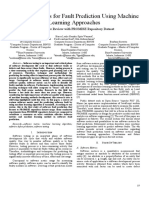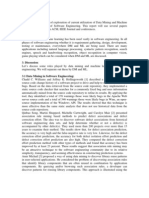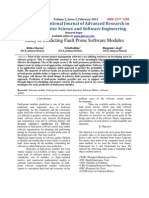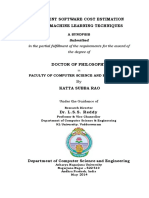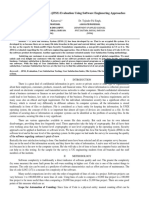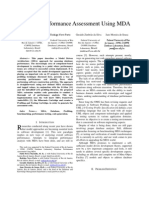0 ratings0% found this document useful (0 votes)
6 viewsSoftware Defect Prediction
Uploaded by
sahilverma20652Copyright
© © All Rights Reserved
Available Formats
Download as PPTX, PDF, TXT or read online on Scribd
0 ratings0% found this document useful (0 votes)
6 viewsSoftware Defect Prediction
Uploaded by
sahilverma20652Copyright
© © All Rights Reserved
Available Formats
Download as PPTX, PDF, TXT or read online on Scribd
You are on page 1/ 14
Software Defect Prediction
Submitted To : Submitted By :
Priya Singh Sahil Verma
Department of Software Department of Software
Engineering, Delhi Technological Engineering, Delhi Technological
University, University,
Delhi, India Delhi, India
priya.singh.academia@gmail.com Sahilverma.1802@gmail.com
INTRODUCTION
Software Defect Prediction (SDP) is a critical research area in software
engineering focused on identifying software defects before deployment.
The primary objectives of SDP include improving software quality,
enhancing reliability, and reducing maintenance costs by early detection
of fault components.
Traditional manual testing and debugging processes have become
challenging due to the growing complexity of software systems
These models analyze data patterns to classify software components into
defective and non-defective categories.
OBJECTIVES
SDP is a specialized domain in software engineering focused on
identifying defects in software systems before production.
The primary goal is to detect code sections more likely to contain
errors.
Utilizes advanced techniques including: Machine learning,
Statistical analysis.
Enables more software development practices.
Provides insights for selecting the best suitable embedding
techniques for SDP tasks.
Helps create more robust, stable, and high-performing software
applications.
SOFTWARE DEFECT PREDICTION
Software Defect Prediction is essential
for the quality of the software,
reliability, and efficiency of software
systems. It allows identifying early
defects in a software system, which is
becoming increasingly important due
to the increasing complexity of Figure 1. Flowchart of SDP
software applications and demand on
speed for delivery.
DATASET USED
METHODOLOGY
The methodology involves the use
of a large-scale dataset :
PyTraceBugs Dataset
Unique Code Study
Plagiarism Detection in
Documents
Duplication and Near-Duplication
Detection
The following figures illustrates the
Figure 2. Flowchart for
process followed during this study.
predicting bug
PyTraceBugs Dataset
Collected the PyTraceBugs dataset at a large-scale, which
consists of over 24,000 buggy snippets and 5.7 million
repaired ones.
Fine-tune Python-specific BERT embeddings while
classifying buggy and correct code in a binary defect
prediction setup.
Evaluate model performance based on precision, recall,
and F1-score metrics.
Unique Code Study
Analyzed Syntactic Redundancy using token-based
measures and Hamming distance.
Analyzing around 420 million lines of code belonging to
about 6,000 software projects.
Searched through statistical redundancy metrics to
explore the patterns and similarities.
Plagiarism Detection in
Reviewed systems such as Turnitin, SafeAssign, and EVE.
Documents
String matching, tokenization, and heuristic-based
comparisons against proprietary databases have been
used.
Plagiarism is further detected through similarity scores
and percentage matches.
Duplication and Near-Duplication
Detection
Used a watermark-based system to identify plagiarized
code in programming assignments.
Classified students into copier or supplier categories using
binary processing.
Benchmarked against systems like MOSS to highlight
advantages of direct plagiarism detection.
RESULT
The following pie chart and graph
shows the Distribution of
publications by year and Publications
by different sources.
CONCLUSION
Machine learning and natural language processing are driving
significant role in software engineering processes.
A breakthrough in defect prediction due to its large-size, diverse
corpora that address limitations of earlier datasets.
Innovations in plagiarism detection and text summarization between
NLP and software engineering.
Research on detecting redundancy and ensuring uniqueness improves
software quality and maintainability.
FUTURE WORK
Enhanced Defect Detection
Develop models that better understand code semantics for enhanced
accuracy in plagiarism detection and defect prediction.
Design computationally efficient algorithms and cloud-based
solutions for large-scale data processing in defect prediction and
redundancy detection.
Advanced techniques, diverse datasets can significantly improve SDP
models.
THANK-YOU
You might also like
- A novel approach to enhancing software quality assurance through early detection and prevention of software faultsNo ratings yetA novel approach to enhancing software quality assurance through early detection and prevention of software faults13 pages
- Improving Software Development Process Through Data Mining Techniques of Unsupervised Algorithms IJERTV10IS110002No ratings yetImproving Software Development Process Through Data Mining Techniques of Unsupervised Algorithms IJERTV10IS1100024 pages
- Software Metrics For Fault Prediction Using Machine Learning ApproachesNo ratings yetSoftware Metrics For Fault Prediction Using Machine Learning Approaches5 pages
- A Systematic Literature Review On Fault Prediction Performance in Software Engineering100% (2)A Systematic Literature Review On Fault Prediction Performance in Software Engineering7 pages
- Software Defect Prediction: A Survey With Machine Learning ApproachNo ratings yetSoftware Defect Prediction: A Survey With Machine Learning Approach6 pages
- Ahts04 Sandia National Laboratories: Multimodal Deep Learning For Flaw Detection in Software ProgramsNo ratings yetAhts04 Sandia National Laboratories: Multimodal Deep Learning For Flaw Detection in Software Programs13 pages
- A Case Study On Machine Learning Model For Code ReNo ratings yetA Case Study On Machine Learning Model For Code Re8 pages
- Comprehensive Study On Machine LearningNo ratings yetComprehensive Study On Machine Learning10 pages
- Deep Learning Software Defect Prediction Methods FNo ratings yetDeep Learning Software Defect Prediction Methods F11 pages
- Study of Predicting Fault Prone Software ModulesNo ratings yetStudy of Predicting Fault Prone Software Modules3 pages
- When A Patch Goes Bad Exploring The Properties ofNo ratings yetWhen A Patch Goes Bad Exploring The Properties of10 pages
- Python Code Smells Detection Using Conventional Machine Learning ModelsNo ratings yetPython Code Smells Detection Using Conventional Machine Learning Models21 pages
- Applying Machine Learning To Software Fault Prediction: Bartłomiej Wójcicki, Robert DąbrowskiNo ratings yetApplying Machine Learning To Software Fault Prediction: Bartłomiej Wójcicki, Robert Dąbrowski18 pages
- An Empirical Study On Application of Word Embedding Techniques For Prediction of Software Defect Severity LevelNo ratings yetAn Empirical Study On Application of Word Embedding Techniques For Prediction of Software Defect Severity Level8 pages
- A Survey of Different Machine Learning MNo ratings yetA Survey of Different Machine Learning M13 pages
- Efficient Software Cost Estimation Using Machine Learning TechniquesNo ratings yetEfficient Software Cost Estimation Using Machine Learning Techniques20 pages
- Deep Learning Based Software Defect PredictionNo ratings yetDeep Learning Based Software Defect Prediction11 pages
- Privacy Preserving Mining in Code Profiling Data: ISSN (ONLINE) : 2250-0758, ISSN (PRINT) : 2394-6962No ratings yetPrivacy Preserving Mining in Code Profiling Data: ISSN (ONLINE) : 2250-0758, ISSN (PRINT) : 2394-69625 pages
- Software Development Analytics for Xen Why and HowNo ratings yetSoftware Development Analytics for Xen Why and How10 pages
- Assessing Personalized Software Defect PredictorsNo ratings yetAssessing Personalized Software Defect Predictors4 pages
- Software Quality Assessment of A Web Application For Biomedical Data AnalysisNo ratings yetSoftware Quality Assessment of A Web Application For Biomedical Data Analysis10 pages
- Java File Security System (JFSS) Evaluation Using Software Engineering ApproachesNo ratings yetJava File Security System (JFSS) Evaluation Using Software Engineering Approaches6 pages
- An Effect of Particle Swarm Optimization On SDLC: Shrishti Tamrakar (M.Tech Scholar), Anubhav Sharma (Asst - Prof.)No ratings yetAn Effect of Particle Swarm Optimization On SDLC: Shrishti Tamrakar (M.Tech Scholar), Anubhav Sharma (Asst - Prof.)7 pages
- M.Phil Computer Science Knowledge and Data Engineering ProjectsNo ratings yetM.Phil Computer Science Knowledge and Data Engineering Projects2 pages
- Fuzzy C Means Method For Cross - Project Software Defect PredictionNo ratings yetFuzzy C Means Method For Cross - Project Software Defect Prediction10 pages
- The Automation Revolution in Software DevelopmentNo ratings yetThe Automation Revolution in Software Development9 pages
- Deep Learning for Software Defect Prediction- A SurveyNo ratings yetDeep Learning for Software Defect Prediction- A Survey6 pages
- Ieee 2012 Projects Software Engineering at Seabirds (Cochin, Thiruvananthapuram, Mysore, Mangalore, Hubli, Chennai, Trichy)No ratings yetIeee 2012 Projects Software Engineering at Seabirds (Cochin, Thiruvananthapuram, Mysore, Mangalore, Hubli, Chennai, Trichy)7 pages
- Software Engineering What It Is, Definition, TutNo ratings yetSoftware Engineering What It Is, Definition, Tut2 pages
- Database Performance Assessment Using MDA: AbstractNo ratings yetDatabase Performance Assessment Using MDA: Abstract6 pages
- A Buffer Overflow Prediction Approach Based On SofNo ratings yetA Buffer Overflow Prediction Approach Based On Sof13 pages
- On The Effectiveness of Developer Features in Code Smell Prioritization - A Replication StudyNo ratings yetOn The Effectiveness of Developer Features in Code Smell Prioritization - A Replication Study23 pages
- Exploring Metaheuristic Optimized Machine LearningNo ratings yetExploring Metaheuristic Optimized Machine Learning45 pages
- Comparative Analysis of Software Reliability Prediction Using Machine Learning and Deep LearningNo ratings yetComparative Analysis of Software Reliability Prediction Using Machine Learning and Deep Learning6 pages
- Using Fuzzy Clustering and Software Metrics To Predict Faults in Large Industrial Software SystemsNo ratings yetUsing Fuzzy Clustering and Software Metrics To Predict Faults in Large Industrial Software Systems5 pages
- Malware-Analysis-and-Detection-Using-Machine-Learning-AlgorithmNo ratings yetMalware-Analysis-and-Detection-Using-Machine-Learning-Algorithm4 pages
- 994-0089 D400 Substation Gateway Hardware User Manual v1.30 R12No ratings yet994-0089 D400 Substation Gateway Hardware User Manual v1.30 R12124 pages
- Radio Engineering - Design Exercise 2016 v1.0No ratings yetRadio Engineering - Design Exercise 2016 v1.022 pages
- XY-MBZ55A-YC1155-Bluetooth-5-BR-EDR-BLE-module-Datasheet-20211101No ratings yetXY-MBZ55A-YC1155-Bluetooth-5-BR-EDR-BLE-module-Datasheet-2021110127 pages
- Stardom Fcn-Rtu: Low Power Autonomous ControllerNo ratings yetStardom Fcn-Rtu: Low Power Autonomous Controller1 page
- Tbs Mambo Radio: Compact All-In-One Remote Control Radio With TBS Tracer SystemNo ratings yetTbs Mambo Radio: Compact All-In-One Remote Control Radio With TBS Tracer System49 pages
- Edwards, Jonathan - Charity and Its Fruits (New York, 1852)100% (1)Edwards, Jonathan - Charity and Its Fruits (New York, 1852)566 pages
- 5G&EMF Explained - AMTA - 23aug - 2019 - 20No ratings yet5G&EMF Explained - AMTA - 23aug - 2019 - 2012 pages
- WWW Csselectronics Com Pages Lin Bus Protocol Intro BasicsNo ratings yetWWW Csselectronics Com Pages Lin Bus Protocol Intro Basics18 pages
- VSAM Interview Questions and Answers 214No ratings yetVSAM Interview Questions and Answers 21413 pages
- Electrical Safety For Ships, Mobile and Fixed Offshore PlatformsNo ratings yetElectrical Safety For Ships, Mobile and Fixed Offshore Platforms20 pages
- ADB - Unit - III (Chapter-2) - Query Processing and DecompositionNo ratings yetADB - Unit - III (Chapter-2) - Query Processing and Decomposition42 pages
- Oracle 11g Business Intelligence Enterprise Edition (OBIEE)No ratings yetOracle 11g Business Intelligence Enterprise Edition (OBIEE)6 pages
- A novel approach to enhancing software quality assurance through early detection and prevention of software faultsA novel approach to enhancing software quality assurance through early detection and prevention of software faults
- Improving Software Development Process Through Data Mining Techniques of Unsupervised Algorithms IJERTV10IS110002Improving Software Development Process Through Data Mining Techniques of Unsupervised Algorithms IJERTV10IS110002
- Software Metrics For Fault Prediction Using Machine Learning ApproachesSoftware Metrics For Fault Prediction Using Machine Learning Approaches
- A Systematic Literature Review On Fault Prediction Performance in Software EngineeringA Systematic Literature Review On Fault Prediction Performance in Software Engineering
- Software Defect Prediction: A Survey With Machine Learning ApproachSoftware Defect Prediction: A Survey With Machine Learning Approach
- Ahts04 Sandia National Laboratories: Multimodal Deep Learning For Flaw Detection in Software ProgramsAhts04 Sandia National Laboratories: Multimodal Deep Learning For Flaw Detection in Software Programs
- A Case Study On Machine Learning Model For Code ReA Case Study On Machine Learning Model For Code Re
- Deep Learning Software Defect Prediction Methods FDeep Learning Software Defect Prediction Methods F
- Python Code Smells Detection Using Conventional Machine Learning ModelsPython Code Smells Detection Using Conventional Machine Learning Models
- Applying Machine Learning To Software Fault Prediction: Bartłomiej Wójcicki, Robert DąbrowskiApplying Machine Learning To Software Fault Prediction: Bartłomiej Wójcicki, Robert Dąbrowski
- An Empirical Study On Application of Word Embedding Techniques For Prediction of Software Defect Severity LevelAn Empirical Study On Application of Word Embedding Techniques For Prediction of Software Defect Severity Level
- Efficient Software Cost Estimation Using Machine Learning TechniquesEfficient Software Cost Estimation Using Machine Learning Techniques
- Privacy Preserving Mining in Code Profiling Data: ISSN (ONLINE) : 2250-0758, ISSN (PRINT) : 2394-6962Privacy Preserving Mining in Code Profiling Data: ISSN (ONLINE) : 2250-0758, ISSN (PRINT) : 2394-6962
- Software Development Analytics for Xen Why and HowSoftware Development Analytics for Xen Why and How
- Software Quality Assessment of A Web Application For Biomedical Data AnalysisSoftware Quality Assessment of A Web Application For Biomedical Data Analysis
- Java File Security System (JFSS) Evaluation Using Software Engineering ApproachesJava File Security System (JFSS) Evaluation Using Software Engineering Approaches
- An Effect of Particle Swarm Optimization On SDLC: Shrishti Tamrakar (M.Tech Scholar), Anubhav Sharma (Asst - Prof.)An Effect of Particle Swarm Optimization On SDLC: Shrishti Tamrakar (M.Tech Scholar), Anubhav Sharma (Asst - Prof.)
- M.Phil Computer Science Knowledge and Data Engineering ProjectsM.Phil Computer Science Knowledge and Data Engineering Projects
- Fuzzy C Means Method For Cross - Project Software Defect PredictionFuzzy C Means Method For Cross - Project Software Defect Prediction
- Deep Learning for Software Defect Prediction- A SurveyDeep Learning for Software Defect Prediction- A Survey
- Ieee 2012 Projects Software Engineering at Seabirds (Cochin, Thiruvananthapuram, Mysore, Mangalore, Hubli, Chennai, Trichy)Ieee 2012 Projects Software Engineering at Seabirds (Cochin, Thiruvananthapuram, Mysore, Mangalore, Hubli, Chennai, Trichy)
- Database Performance Assessment Using MDA: AbstractDatabase Performance Assessment Using MDA: Abstract
- A Buffer Overflow Prediction Approach Based On SofA Buffer Overflow Prediction Approach Based On Sof
- On The Effectiveness of Developer Features in Code Smell Prioritization - A Replication StudyOn The Effectiveness of Developer Features in Code Smell Prioritization - A Replication Study
- Exploring Metaheuristic Optimized Machine LearningExploring Metaheuristic Optimized Machine Learning
- Comparative Analysis of Software Reliability Prediction Using Machine Learning and Deep LearningComparative Analysis of Software Reliability Prediction Using Machine Learning and Deep Learning
- Using Fuzzy Clustering and Software Metrics To Predict Faults in Large Industrial Software SystemsUsing Fuzzy Clustering and Software Metrics To Predict Faults in Large Industrial Software Systems
- Malware-Analysis-and-Detection-Using-Machine-Learning-AlgorithmMalware-Analysis-and-Detection-Using-Machine-Learning-Algorithm
- Defect Prediction in Software Development & MaintainenceFrom EverandDefect Prediction in Software Development & Maintainence
- 994-0089 D400 Substation Gateway Hardware User Manual v1.30 R12994-0089 D400 Substation Gateway Hardware User Manual v1.30 R12
- XY-MBZ55A-YC1155-Bluetooth-5-BR-EDR-BLE-module-Datasheet-20211101XY-MBZ55A-YC1155-Bluetooth-5-BR-EDR-BLE-module-Datasheet-20211101
- Tbs Mambo Radio: Compact All-In-One Remote Control Radio With TBS Tracer SystemTbs Mambo Radio: Compact All-In-One Remote Control Radio With TBS Tracer System
- Edwards, Jonathan - Charity and Its Fruits (New York, 1852)Edwards, Jonathan - Charity and Its Fruits (New York, 1852)
- WWW Csselectronics Com Pages Lin Bus Protocol Intro BasicsWWW Csselectronics Com Pages Lin Bus Protocol Intro Basics
- Electrical Safety For Ships, Mobile and Fixed Offshore PlatformsElectrical Safety For Ships, Mobile and Fixed Offshore Platforms
- ADB - Unit - III (Chapter-2) - Query Processing and DecompositionADB - Unit - III (Chapter-2) - Query Processing and Decomposition
- Oracle 11g Business Intelligence Enterprise Edition (OBIEE)Oracle 11g Business Intelligence Enterprise Edition (OBIEE)



